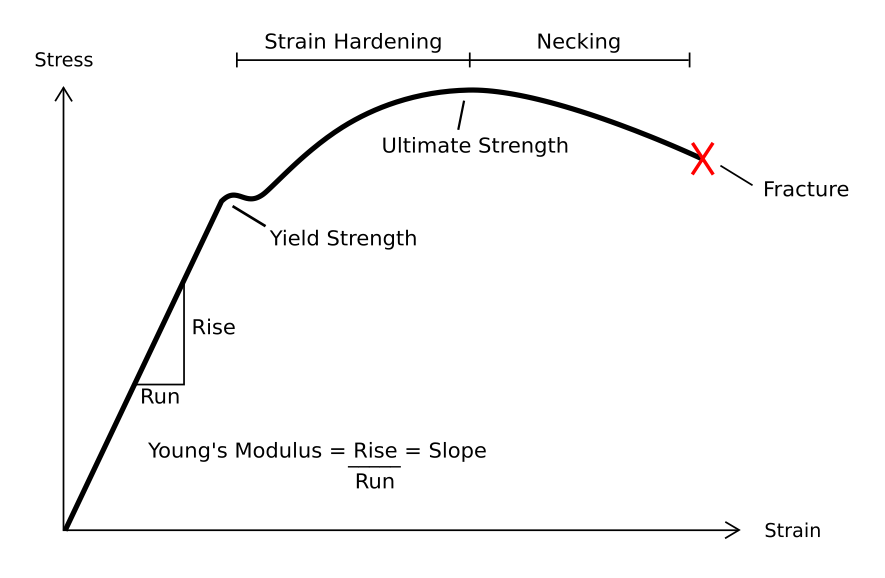|
Contraflexure
In solid mechanics, a point along a beam under a lateral load is known as a point of contraflexure if the bending moment about the point equals zero. In a bending moment diagram, it is the point at which the bending moment curve intersects with the zero line (i.e. where the bending moment reverses direction along the beam). Knowing the place of the contraflexure is especially useful when designing reinforced concrete or structural steel beams and also for designing bridges. Flexural reinforcement may be reduced at this point. However, to omit reinforcement at the point of contraflexure entirely is inadvisable as the actual location is unlikely to realistically be defined with confidence. Additionally, an adequate quantity of reinforcement should extend beyond the point of contraflexure to develop bond strength and to facilitate shear force transfer. See also * Deformation * Engineering mechanics * Flexural rigidity * Flexural stress * Fluid mechanics * Inflection point * Str ... [...More Info...] [...Related Items...] OR: [Wikipedia] [Google] [Baidu] |
Solid Mechanics
Solid mechanics (also known as mechanics of solids) is the branch of continuum mechanics that studies the behavior of solid materials, especially their motion and deformation (mechanics), deformation under the action of forces, temperature changes, phase (chemistry), phase changes, and other external or internal agents. Solid mechanics is fundamental for civil engineering, civil, Aerospace engineering, aerospace, nuclear engineering, nuclear, Biomedical engineering, biomedical and mechanical engineering, for geology, and for many branches of physics and chemistry such as materials science. It has specific applications in many other areas, such as understanding the anatomy of living beings, and the design of dental prosthesis, dental prostheses and surgical implants. One of the most common practical applications of solid mechanics is the Euler–Bernoulli beam theory, Euler–Bernoulli beam equation. Solid mechanics extensively uses tensors to describe stresses, strains, and the r ... [...More Info...] [...Related Items...] OR: [Wikipedia] [Google] [Baidu] |
Beam (structure)
A beam is a structural element that primarily resists loads applied laterally across the beam's axis (an element designed to carry a load pushing parallel to its axis would be a strut or column). Its mode of deflection is primarily by bending, as loads produce reaction forces at the beam's support points and internal bending moments, shear, stresses, strains, and deflections. Beams are characterized by their manner of support, profile (shape of cross-section), equilibrium conditions, length, and material. Beams are traditionally descriptions of building or civil engineering structural elements, where the beams are horizontal and carry vertical loads. However, any structure may contain beams, such as automobile frames, aircraft components, machine frames, and other mechanical or structural systems. Any structural element, in any orientation, that primarily resists loads applied laterally across the element's axis is a beam. Overview Historically a beam is a squared ti ... [...More Info...] [...Related Items...] OR: [Wikipedia] [Google] [Baidu] |
Structural Load
A structural load or structural action is a mechanical load (more generally a force) applied to Structural engineering#Structural elements, structural elements. A load causes stress (physics), stress, deformation (engineering), deformation, displacement (vector), displacement or acceleration in a structure. Structural analysis, a discipline in engineering, analyzes the effects of loads on structures and structural elements. Excess load may cause structural failure, so this should be considered and controlled during the design of a structure. Particular mechanical structures—such as aircraft, satellites, rockets, space stations, ships, and submarines—are subject to their own particular structural loads and actions. Engineers often evaluate structural loads based upon published regulations, contracts, or specifications. Accepted technical standards are used for acceptance testing and inspection. Types In civil engineering, specified loads are the best estimate of the actual l ... [...More Info...] [...Related Items...] OR: [Wikipedia] [Google] [Baidu] |
Bending Moment
In solid mechanics, a bending moment is the Reaction (physics), reaction induced in a structural element when an external force or Moment of force, moment is applied to the element, causing the element to bending, bend. The most common or simplest structural element subjected to bending moments is the Beam (structure), beam. The diagram shows a beam which is simply supported (free to rotate and therefore lacking bending moments) at both ends; the ends can only react to the Shear stress, shear loads. Other beams can have both ends fixed (known as encastre beam); therefore each end support has both bending moments and shear reaction loads. Beams can also have one end fixed and one end simply supported. The simplest type of beam is the cantilever, which is fixed at one end and is free at the other end (neither simple nor fixed). In reality, beam supports are usually neither absolutely fixed nor absolutely rotating freely. The internal reaction loads in a cross section (geometry), cr ... [...More Info...] [...Related Items...] OR: [Wikipedia] [Google] [Baidu] |
Shear And Moment Diagram
Shear force and bending moment diagrams are analytical tools used in conjunction with structural analysis to help perform structural design by determining the value of shear forces and bending moments at a given point of a structural element such as a beam. These diagrams can be used to easily determine the type, size, and material of a member in a structure so that a given set of loads can be supported without structural failure. Another application of shear and moment diagrams is that the deflection of a beam can be easily determined using either the moment area method or the conjugate beam method. Convention Although these conventions are relative and any convention can be used if stated explicitly, practicing engineers have adopted a standard convention used in design practices. Normal convention The normal convention used in most engineering applications is to label a positive shear force - one that spins an element clockwise (up on the left, and down on the right). Like ... [...More Info...] [...Related Items...] OR: [Wikipedia] [Google] [Baidu] |
Reinforced Concrete
Reinforced concrete, also called ferroconcrete or ferro-concrete, is a composite material in which concrete's relatively low tensile strength and ductility are compensated for by the inclusion of reinforcement having higher tensile strength or ductility. The reinforcement is usually, though not necessarily, steel reinforcing bars (known as rebar) and is usually embedded passively in the concrete before the concrete sets. However, post-tensioning is also employed as a technique to reinforce the concrete. In terms of volume used annually, it is one of the most common engineering materials. In corrosion engineering terms, when designed correctly, the alkalinity of the concrete protects the steel rebar from corrosion. Description Reinforcing schemes are generally designed to resist tensile stresses in particular regions of the concrete that might cause unacceptable cracking and/or structural failure. Modern reinforced concrete can contain varied reinforcing materials made o ... [...More Info...] [...Related Items...] OR: [Wikipedia] [Google] [Baidu] |
Structural Steel
Structural steel is steel used for making construction materials in a variety of shapes. Many structural steel shapes take the form of an elongated beam having a profile of a specific cross section (geometry), cross section. Structural steel shapes, sizes, chemical composition, mechanical properties such as strengths, storage practices, etc., are regulated by Technical standard, standards in most industrialized countries. Structural steel shapes, such as I-beams, have high Second moment of area, second moments of area, so can support a high Structural load, load without excessive Hogging and sagging, sagging. Structural shapes The shapes available are described in published standards worldwide, and specialist, proprietary cross sections are also available. *I-beam, I-beam (serif capital 'I'-shaped cross-section – in Britain these include Universal Beams (UB) and Universal Columns (UC); in Europe it includes the IPE, HE, HL, HD and other sections; in the US it includes Wide ... [...More Info...] [...Related Items...] OR: [Wikipedia] [Google] [Baidu] |
Deformation (engineering)
In engineering, deformation (the change in size or shape of an object) may be ''elastic'' or ''plastic''. If the deformation is negligible, the object is said to be ''rigid''. Main concepts Occurrence of deformation in engineering applications is based on the following background concepts: * ''Displacements'' are any change in position of a point on the object, including whole-body translations and rotations ( rigid transformations). * ''Deformation'' are changes in the relative position between internals points on the object, excluding rigid transformations, causing the body to change shape or size. * ''Strain'' is the ''relative'' ''internal'' deformation, the dimensionless change in shape of an infinitesimal cube of material relative to a reference configuration. Mechanical strains are caused by mechanical stress, ''see stress-strain curve''. The relationship between stress and strain is generally linear and reversible up until the yield point and the deformation is ... [...More Info...] [...Related Items...] OR: [Wikipedia] [Google] [Baidu] |
Flexural Rigidity
Flexural rigidity is defined as the force couple required to bend a fixed non- rigid structure by one unit of curvature, or as the resistance offered by a structure while undergoing bending. Flexural rigidity of a beam Although the moment M(x) and displacement y generally result from external loads and may vary along the length of the beam or rod, the flexural rigidity (defined as EI) is a property of the beam itself and is generally constant for prismatic members. However, in cases of non-prismatic members, such as the case of the tapered beams or columns or notched stair stringers, the flexural rigidity will vary along the length of the beam as well. The flexural rigidity, moment, and transverse displacement are related by the following equation along the length of the rod, x: :\ EI \ = \int_^ M(x) dx + C_1 where E is the flexural modulus (in Pa), I is the second moment of area (in m4), y is the transverse displacement of the beam at x, and M(x) is the bending moment at ''x' ... [...More Info...] [...Related Items...] OR: [Wikipedia] [Google] [Baidu] |
Flexural Stress
Flexural strength, also known as modulus of rupture, or bend strength, or transverse rupture strength is a material property, defined as the stress in a material just before it yields in a flexure test. The transverse bending test is most frequently employed, in which a specimen having either a circular or rectangular cross-section is bent until fracture or yielding using a three-point flexural test technique. The flexural strength represents the highest stress experienced within the material at its moment of yield. It is measured in terms of stress, here given the symbol \sigma. Introduction When an object is formed of a single material, like a wooden beam or a steel rod, is bent (Fig. 1), it experiences a range of stresses across its depth (Fig. 2). At the edge of the object on the inside of the bend (concave face) the stress will be at its maximum compressive stress value. At the outside of the bend (convex face) the stress will be at its maximum tensile value. These ... [...More Info...] [...Related Items...] OR: [Wikipedia] [Google] [Baidu] |
Fluid Mechanics
Fluid mechanics is the branch of physics concerned with the mechanics of fluids (liquids, gases, and plasma (physics), plasmas) and the forces on them. Originally applied to water (hydromechanics), it found applications in a wide range of disciplines, including mechanical engineering, mechanical, aerospace engineering, aerospace, civil engineering, civil, chemical engineering, chemical, and biomedical engineering, as well as geophysics, oceanography, meteorology, astrophysics, and biology. It can be divided into ''fluid statics'', the study of various fluids at rest; and ''fluid dynamics'', the study of the effect of forces on fluid motion. It is a branch of ''continuum mechanics'', a subject which models matter without using the information that it is made out of atoms; that is, it models matter from a macroscopic viewpoint rather than from microscopic. Fluid mechanics, especially fluid dynamics, is an active field of research, typically mathematically complex. Many problems a ... [...More Info...] [...Related Items...] OR: [Wikipedia] [Google] [Baidu] |


